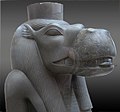Taweret
| Taweret in hieroglyphics | |||||||
|---|---|---|---|---|---|---|---|
| mostly |
Taweret T3 would be the big one |
||||||
| or |
Taweret T3 wrt´3t The big one |
||||||
| Taweret with Sa loop | |||||||
Taweret is the protective goddess of pregnant women in Egyptian mythology .
Other spellings
This deity is also known by the synonyms Tauret and its Greek name Toeris . Sometimes there are also the spellings Thoëris , Taueret , Taurt and Tueris , which go back to older phonetic translations of the hieroglyphic writing .
meaning
Her name Ta-weret means "the great one". In mythology she is worshiped partly as an animal form of the goddess Mut , but partly also as an independent deity. In texts she is considered the daughter of Re , mother of Isis and Osiris and wife of Seth .
In some cases, statues of the goddess are said to have been hung with the robes of pregnant or breastfeeding women in order to give them special protective power.
In the Old Kingdom , Taweret was considered to be particularly benevolent, especially during childbirth . In later times it will also be assigned characteristics of a demon . For example, it should devour the dead who do not pass the judgment of the dead before Osiris, thereby depriving them of the possibility of eternal life. In connection with this examination of the deceased for a righteous life, the deities Anubis , Maat and Thoth have a special meaning.
In Gebel el-Silsile , Taweret was associated with the Nile flood.
presentation
Taweret is depicted as an upright pregnant hippopotamus with a partly hippopotamus or lion-like head, lion arms and legs, a crocodile tail and human breasts. In the front paws the figure wears Sa-ribbons and sometimes a burning torch to ward off demons . There are also occasional images showing them with a human head and the horns of the sun disk of the goddess Hathor . Representations of the goddess can be found as sculptures and on wall paintings in Egyptian tombs.
small wooden sculpture of Queen Teje as Taweret in the Egyptian Museum Turin
Statue of Taweret in the Egyptian Museum Cairo , inventory number CG 39194
Cult places
Taweret was worshiped in Deir el-Medina , Fayyum , Abu Simbel, and western Gebel es-Sisile.
See also
literature
- Christian Leitz u. a. (Ed.): Lexicon of the Egyptian gods and names of gods . Volume 7: š - ḏ. (= Orientalia Lovaniensia analecta. Volume 116). Peeters, Leuven et al. a. 2002, ISBN 90-429-1152-2 .
- Richard H. Wilkinson : The world of the gods in ancient Egypt. Faith - Power - Mythology. Theiss, Stuttgart 2003, ISBN 3-8062-1819-6 , pp. 185-186.
Web links
Remarks
- ↑ Writing from the Greco-Roman period ; see. on this: Christian Leitz u. a. (Ed.): Lexicon of the Egyptian gods and names of gods. Volume 7: š - ḏ. 2002, p. 332.




